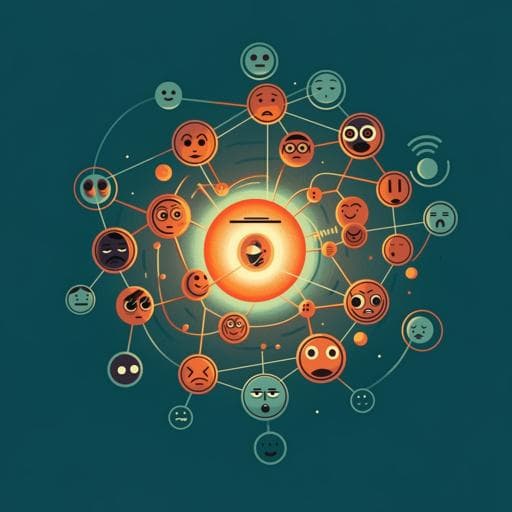
Psychology
Analyzing the effects of memory biases and mood disorders on social performance
N. K. Sreenivas and S. Rao
Explore the fascinating dynamics of emotional influences on social performance in this research by Nanda Kishore Sreenivas and Shrisha Rao. Discover how different mood states affect agent behavior, with manic agents showcasing superior performance while depressed agents lag behind. This study introduces innovative concepts like memory biases and mood disorders within an integrated agent-based model.
~3 min • Beginner • English
Introduction
The study investigates how memory biases and mood disorders influence decision-making and social performance within agent societies. Prior models often assumed perfect rationality or examined single biases in isolation. Psychological and behavioral research indicates that humans are subject to diverse cognitive biases and that emotion and mood shape memory, expectations, and social engagement. The authors aim to integrate emotion (via appraisal theory), mood (including mood dependence in retrieval), memory encoding and forgetting, and social behaviors (drive to interact and network size) into a single agent-based framework. They model rational, manic, depressed, and bipolar agents interacting repeatedly in a network through a Continuous Prisoner’s Dilemma, to quantify how these traits and disorders affect cooperation and resulting payoffs. The purpose is to provide computational insights aligned with psychological findings and to explore under-studied mechanisms such as mood-dependent memory retrieval and their impact on social outcomes.
Literature Review
The Background synthesizes literature on multiple components:
- Forgetting: Classical and modern theories include decay- and interference-based accounts. Empirical analyses support logarithmic, exponential, hyperbolic, and power-law forgetting, with exponential and power functions commonly used. The recency effect and the idea that forgetting can sometimes aid decision optimization are noted.
- Emotions and memory: Evidence suggests emotional events are remembered better, particularly central details. Appraisal theory frames emotion as evaluation relative to goals/expectations. Findings on valence asymmetry are mixed, with reports of both positivity and negativity advantages. A pervasive negativity bias implies greater processing and recall of negative information.
- Mood and memory: Mood influences retrieval (mood dependence), with better recall for mood-congruent memories, supported by neuroimaging and human studies; however, computational models of mood-dependent retrieval are lacking.
- Mood disorders: Bipolar disorder features manic–depressed cycling; models include rhythmic, discrete, and BAS-dysregulation frameworks, with clinical links to circadian rhythms. Depression involves anhedonia and reduced reward sensitivity; mania involves elevated mood, drive, and reward sensitivity. Computational approaches often model reward sensitivity to capture hypo-/hyper-sensitivity. Social networks and engagement differ by mood disorder, with depressed individuals having smaller networks and lower drive; manic behavior can involve atypical social actions.
Methodology
The authors build an agent-based model of social interaction grounded in psychology.
- Population and network: An agent society χ is represented as an undirected graph G=(χ, ε). Agents interact only with neighbors; node degree determines personal network size n_A, which depends on agent type.
- Interaction game: Agents play a Continuous Prisoner’s Dilemma (CPD), choosing cooperation levels c_A, c_B ∈ [0,1]. Payoffs P_A(c_A,c_B) are derived by linear interpolation from the standard PD payoffs (T > C > D > S, with 2C > T + D).
- Expectation and cooperation: For agent A paired with B at time t, A retrieves relevant memory traces L_t of past interactions with B. Expectation E_A(B) is the average of B’s past cooperation in L_t. Primary behavioral rule: A cooperates at c_A = E_A(B).
- Emotion and mood: Emotion (appraisal) is δ_t^A = c_B − c_A (rational baseline). Mood v^A is updated via v^A = tanh(v^A + κ_A(β − 1)), where κ_A ∈ [0,1] controls mood lability.
- Memory encoding: Each interaction yields a trace with initial strength φ_0 set by a linear function of emotion with separate gradients for negative and positive emotions: φ_0 = (−k_N·β)+c for β≤0; φ_0 = (k_P·β)+c for β>0. Emotional bias ξ = k_P/k_N classifies agents as positively (ξ>1), negatively (ξ<1), or neutrally biased.
- Forgetting: Trace strength decays exponentially φ = φ_0 e^(−θ t) with rate θ>0; traces below φ_min are deleted. Successful retrieval refreshes a trace to φ_0. Duration d before deletion (without retrieval) satisfies d = −(1/θ) ln(φ_min/φ_0).
- Mood-dependent retrieval: From filtered traces L (pertaining to B), retrieval likelihood for trace j is p_j = max(0, 1 − γ_A |j^[e] − v|), a triangular function centered at current mood v with selectivity γ_A ≥ 0. Low γ_A yields weak mood dependence (nearly uniform retrieval); high γ_A yields strong mood-congruent retrieval.
- Modeling mood disorders:
• Mania and depression: Modify appraisal using perceived reward with reward sensitivity β_A^t: δ_A^t = tanh(β_A^t c_B − c_A). Depressed agents have 0 ≤ β_A^t ≤ 1 (hyposensitivity/anhedonia), manic agents have β_A^t > 1. Initial mood v_A^0 is set from β_A^0, giving negative initial mood for depressed and positive for manic. A connection diversity parameter π for depressed agents controls the fraction of depressed alters in their network.
• Bipolar disorder: Mood v_A^t = sin(ω_A t) + λ_A, with λ_A (offset; −1 to 1) setting manic/depressed predominance and ω_A controlling period (sampled periodically from an exponential with mean ω_A). Reward sensitivity β_A^t varies with mood per a defined mapping, overestimating reward in mania and underestimating in depression, and is used in δ_A^t.
- Social engagement and network size: Drive to participate ζ_A ∈ [0,1] is a function of β_A^t (trait-like constant per agent), with ζ_A = 0.5 for rational (β=1), lower for depressed (scaled with β<1), and higher for manic (scaled toward β_max). Neighborhood size n_A is similarly scaled with β_A^t, producing smaller networks for depressed and larger for manic; bipolar agents use these mappings with their parameter values.
- Agent attributes: Each agent tracks ID, cumulative payoff, mood v_A^t, mood-change rate κ_A, reward sensitivity β_A^t, neighborhood size n_A, drive ζ_A, neighbor set N_A, and memory parameters: forgetting rate θ_A, threshold φ_min, mood dependence γ_A, encoding gradients (k_A^n, k_A^p), and the set of traces (each storing counterpart ID, cooperation, emotion, initial strength, and current strength).
- Agent types: Four types—rational (β=1, mood 0, ζ=0.5, n_A = 0.5|χ|), manic (β in [1, β_max], positive mood, higher ζ and larger n_A), depressed (β in [0,1], negative mood, lower ζ and smaller n_A), bipolar (sinusoidal mood; additional ω_A, λ_A; ζ and n_A per mappings).
- Simulation setup: A society of 200 agents, equally representing the four types (unless varied), is simulated for 2000 rounds. In each round, active agents (participation probability ζ_A) are randomly paired with neighbors. Interactions update payoffs, emotion, mood, and memory. Experimental variations include population composition, depressed agents’ connection diversity π, forgetting rate θ, emotional bias (k_P/k_N), mood dependence γ, and reward sensitivity (extent of mania/depression).
Key Findings
- Relative performance by type (equal 25% representation): Manic agents achieve the highest payoffs; depressed the lowest. On average, manic agents’ payoff is ~70% higher than rational agents; depressed agents’ payoff is ~60% lower; bipolar agents’ payoff is ~10% higher than rational.
- Population composition: Varying a type’s proportion shows little change for rational and depressed agents’ average payoffs as their proportion increases. Increasing the proportion of manic agents reduces their average payoff notably. Bipolar agents’ average payoff increases with their proportion.
- Connection diversity among depressed agents: With equal type representation overall, varying depressed agents’ connection diversity π from 0.2 to 0.5 shows that moderate π yields the highest average payoff for depressed agents.
- Forgetting (memory strength): Lower forgetting (smaller θ; stronger retention) yields better payoffs. For manic agents, very high θ (no/weak memory) reduces payoff by ~4% versus perfect memory. For rational and depressed agents, no memory yields ~10% lower payoff than perfect memory. Bipolar agents perform best with near-perfect memory, outperforming both perfect and no memory cases.
- Emotional bias (encoding gradients): With other parameters fixed, positive bias increases payoff for manic and bipolar agents; effect is ~+12% for bipolar and ~+1% for manic vs baseline. Rational agents show negligible change. Depressed agents perform ~+2% better with negative bias than average.
- Mood-dependent retrieval (γ): For rational agents, varying γ has no significant effect. For manic agents, intermediate γ yields the highest payoff (~+30% vs low γ baseline). For depressed agents, intermediate γ yields the lowest payoff (~−40% vs low γ baseline). For bipolar agents, low γ (weak mood dependence) maximizes payoff.
- Extent of mania/depression (reward sensitivity β): Average payoff varies almost linearly with β. Increasing mania (β>1) increases payoff; increasing depression severity (β<1) decreases payoff, with depressed agents at any level performing worse than manic agents.
Discussion
The integrated agent-based model demonstrates how emotion-driven encoding, mood-dependent retrieval, memory decay, and social factors (drive and network size) jointly shape cooperative behavior and social payoffs. The results address the central question by showing systematic, quantitatively distinct performance profiles for rational, manic, depressed, and bipolar agents. Findings align with psychological and clinical evidence linking depression severity to poorer performance and mania to enhanced performance, reinforcing the model’s ecological plausibility. The near-linear relationships between reward sensitivity and payoffs provide a mechanistic account for empirical observations lacking analytical explanations. Memory strength robustly benefits most agent types, underscoring the functional role of retention in repeated social dilemmas. Emotional bias effects are type-specific: positive bias aids manic and bipolar agents, while negative bias benefits depressed agents, suggesting that how emotion modulates encoding can either amplify or mitigate disorder-specific tendencies. Mood-dependent retrieval exhibits contrasting optima across types—intermediate selectivity advantages manic agents but disadvantages depressed agents, while bipolar agents benefit from weak mood dependence—highlighting that the coupling between current mood and recall can either stabilize or destabilize cooperation depending on underlying affective dynamics. Overall, the model offers insight into how mood and memory processes can produce observed social performance patterns and suggests potential levers (e.g., memory strength, retrieval selectivity) that differentially impact outcomes across mood disorders.
Conclusion
The paper presents an integrated agent-based model that couples appraisal-based emotion, mood dynamics, emotional-bias-driven memory encoding, exponential forgetting, and mood-dependent retrieval with social network structure, drive, and Continuous Prisoner’s Dilemma interactions. Simulations with rational, manic, depressed, and bipolar agents reproduce and extend empirical findings: manic agents markedly outperform rational agents, depressed agents underperform, and bipolar agents modestly outperform rational agents on average; payoffs vary almost linearly with the extent of mania/depression. Stronger memory improves outcomes for most types, and emotional bias and mood-dependent retrieval have type-specific effects (e.g., positive bias benefits manic/bipolar; intermediate mood dependence helps manic but harms depressed; weak mood dependence benefits bipolar). The work highlights mood-dependent retrieval as a previously under-modeled mechanism with significant performance consequences. Future research can refine the psychological realism (e.g., alternative retrieval/forgetting functions, dynamic drive/network size), explore intervention-like manipulations (altering memory parameters or retrieval selectivity), and examine additional traits or biases that are difficult to study empirically.
Limitations
- The study is a computational agent-based simulation without direct clinical or experimental validation; outcomes cannot be used to guide treatments.
- Several constructs are simplified: forgetting is modeled via exponential decay; retrieval selectivity uses a triangular function; alternative functional forms may yield different quantitative effects.
- Drive to participate and network size are treated as trait-like constants mapped from reward sensitivity rather than state variables directly modulated by current mood, reflecting the complexity and ambiguity of mood–behavior links.
- The CPD payoff structure and network formation rules are stylized; real-world social interactions and network dynamics may be more complex.
- Parameter choices (e.g., β_max, ranges for gradients, thresholds) may influence quantitative results and generalizability.
Related Publications
Explore these studies to deepen your understanding of the subject.







